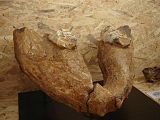Anancus
| Anancus Temporal range:
| |
|---|---|

| |
| One of the most complete A. arvernensis skeletons found clay layers near San Giovanni Valdarno and displayed in the Museo di Storia Naturale di Firenze in Tuscany, Italy | |
| Scientific classification | |
| Domain: | Eukaryota |
| Kingdom: | Animalia |
| Phylum: | Chordata |
| Class: | Mammalia |
| Order: | Proboscidea |
| Superfamily: | Elephantoidea |
| Genus: | †Anancus Aymard, 1855 |
| Species | |
| |
Anancus is an extinct genus of "tetralophodont gomphothere" native to Afro-Eurasia, that lived from the Tortonian stage of the late Miocene until its extinction during the Early Pleistocene, roughly from 8.5–2 million years ago.
Taxonomy
Anancus was named by
Description


Two largely complete individuals of Anancus arvernensis reached shoulder heights of around 2.5–2.6 metres (8 ft 2 in – 8 ft 6 in), with a volumetric estimate suggesting a body mass of around 5.2 to 6 tons, comparable to living African elephants.[6] The tusks were largely straight and lacked enamel[6] (though enamel was present in juveniles[7]) and were slender,[8] and proportionally large, with a large tusk of the species Anancus avernensis from Stoina, Romania measuring 3.71 metres (12.2 ft) in length with an estimated mass of 70 kilograms (150 lb).[9] The tusks varied from projecting forward parallel to each other, to being outwardly divergent from each other, depending on the species.[10] The skull is proportionally tall and short, with an elevated dome and an enlarged tympanic bulla. Unlike more primitive gomphotheres, the mandible was brevirostrine (shortened), and lacked lower tusks. The molars were typically tetralophodont (bearing four crests or ridges) but were pentalophodont in some species. The premolars were absent in all species other than A. kenyensis. On the upper molars, the posterior pretrite central conules were reduced, as were the anterior pretrite central conules on the lower molars. The pretrite and posttrite half-loph(id)s were dislocated from each other, resulting in the successive loph(id)s exhibiting an alternating pattern.[11]
Diet
Dietary preferences of Anancus varied between species. Dental microwear analysis of Anancus arvernensis specimens from the Early Pleistocene of Europe generally suggests that it was a browser, consuming twigs, bark, seeds and fruit,[12] with a browsing diet also proposed for the Early Pliocene South African A. capensis.[13] The East African late Miocene-early Pliocene A. kenyensis and Pliocene A. ultimus have individuals with varying browsing, grazing, and mixed feeding (both browsing and grazing) diets,[14][15] with a grazing diet proposed for Anancus specimens from the Pliocene of India based on isotopic analysis.[16] Anancus osiris from the Pliocene of North Africa is suggested to have been a mixed feeder with a large grass intake based on microwear.[17]
Evolution
Anancus is suggested to have evolved from
Gallery
-
The jaw of Anancus, an extinct relative of the elephant
-
Jaw of Anancus arvernensis from Quaternary of Italy
-
Molar of Anancus arvernensis
References
- .
- S2CID 245023119, retrieved 2023-04-18
- .
- ISBN 978-0-19-854652-8.
- PMID 26756209.
- ^ S2CID 259438457.
- ^ Theodorou, G., Spjeldnaes, N., Hanken, N. M., Lauritzen, S. E., Velitzelos, E., Athanassiou, A., et al. (2000). Description and taphonomic investigations of Neogene Proboscidea from Rhodos, Greece. Annales Géologiques des Pays Helléniques, 38, 133–156.
- ^ .
- ISSN 0891-2963.
- S2CID 91391249.
- ^ S2CID 91391249.
- ^ ISSN 1040-6182.
- S2CID 213999549.
- ^ S2CID 883007.
- PMID 37580434.
- S2CID 210307849.
- S2CID 263714029.
- S2CID 214094348.
- Benes, Josef (1979). Prehistoric Animals and Plants. Prague: Artua. p. 263.



